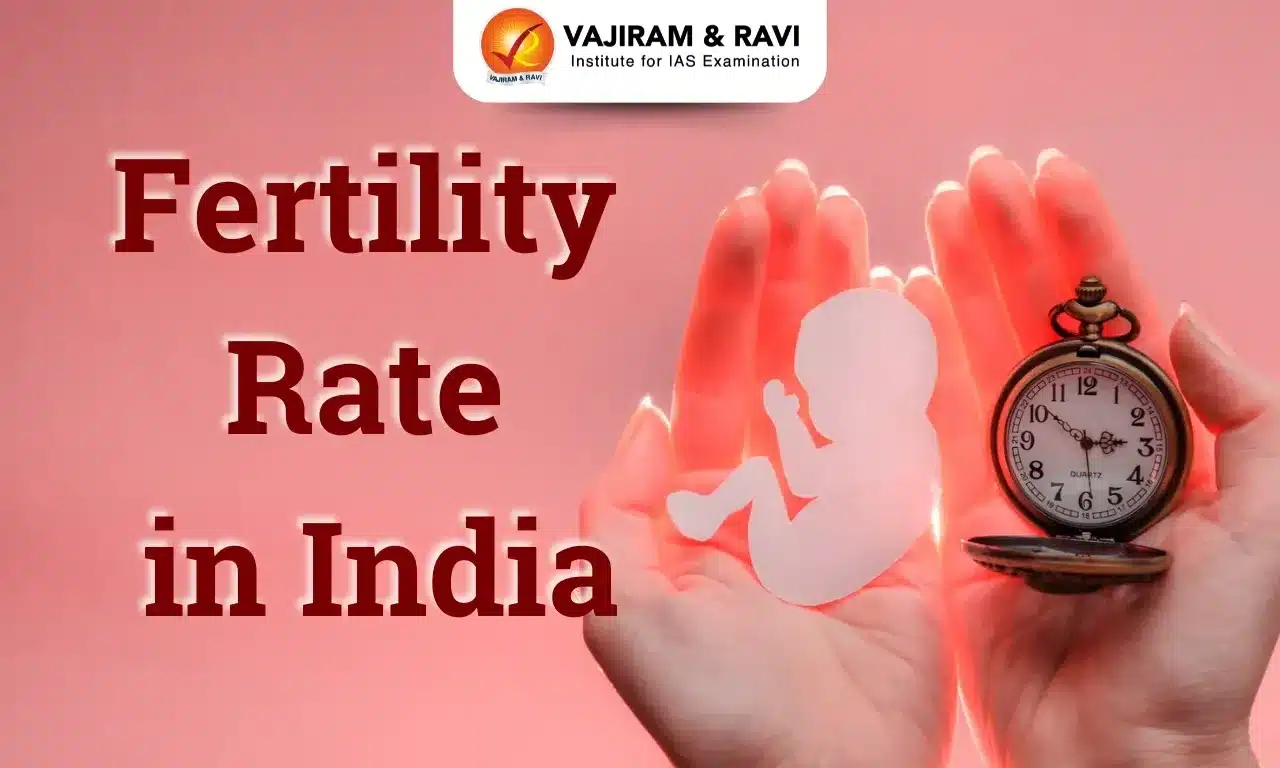What’s in today’s article?
- Introduction
- Reasons for Declining Fertility in India
- Regional Implications
- Global Context
- Future Implications for India
- Way Forward
- Conclusion
Introduction
- A global demographic analysis conducted by the Global Burden of Diseases, Injuries, and Risk Factors Study (GBD) 2021 highlights a significant decline in fertility levels worldwide, including in India.
- The report reveals a dramatic drop in India’s Total Fertility Rate (TFR) from 6.18 in the 1950s to 1.9 in 2021, below the replacement level of 2.1.
- Projections suggest this rate could fall to 1.04 by 2100, signalling major socio-economic implications.
Reasons for Declining Fertility in India
- Increased Female Literacy and Workforce Participation:
- Women’s empowerment and higher educational attainment have contributed significantly to the decline in fertility rates.
- Changing Societal Attitudes:
- Late marriages or choosing not to marry are becoming more common as women prioritize careers and financial independence over traditional roles.
- Infertility and Abortions:
- Rising rates of infertility in men and women and increased abortion rates are also contributing factors.
- Migration:
- Many young individuals move abroad for higher education and employment, often settling there and raising families outside India.
- Urbanization and Modern Aspirations:
- With urbanization, families are opting for fewer children to maintain economic and social aspirations.
Regional Implications
- Southern States
- Kerala and other southern states witnessed demographic transitions earlier than the rest of India, achieving replacement-level fertility in the late 20th century.
- Challenges include:
- Ageing Population: The elderly population is rapidly increasing, surpassing the younger demographic.
- Shrinking Workforce: Youth migration for better prospects has left gaps in the local labor market.
- Healthcare Demands: There is an increased burden on healthcare systems and social security to support the elderly.
- Kerala’s Specific Case:
- Labour Market: High labor wages and quality of life attract migrant workers from other states, making up about one-sixth of the population by 2030.
- Health Challenges: Delayed motherhood leads to older mothers and higher pregnancy-related morbidities.
Global Context
- Countries like South Korea showcase the challenges of reversing fertility declines.
- Despite heavy investments in pro-natalist policies, South Korea’s fertility rate fell from 0.78 in 2022 to 0.73 in 2023, underscoring the difficulty of reversing demographic trends once they set in.
Future Implications for India
- Economic Impacts:
- A shrinking workforce may hinder economic growth.
- Increased healthcare costs due to the ageing population.
- Social Challenges:
- Rising dependency ratios could strain families and welfare systems.
- Reduced innovation and productivity due to fewer young workers.
Way Forward
- Socio-Economic Policies:
- Policies focusing on economic growth, job creation, and support for the youth can help mitigate the effects of declining fertility rates.
- Leveraging the Elderly Population:
- Tap into the potential of senior citizens through skill development and involvement in economic activities.
- Support for Families:
- Provide incentives for young couples to have children, such as tax benefits, childcare support, and housing subsidies.
Conclusion
- India’s declining fertility rates signal a demographic shift with long-term socio-economic implications.
- Proactive policies that address economic, healthcare, and social challenges are crucial to adapting to this transformation.
- Learning from global experiences and focusing on sustainable development will ensure that India navigates these challenges effectively.
Q1. What do you mean by Total Fertility Rate (TFR)?
The number of children that would be born to a woman if she were to live to the end of her childbearing years and bear children in accordance with age-specific fertility rates currently observed. The reference period is three years preceding the survey.
Q2. What is a good Population Pyramid?
Straight or near vertical sides depict a low death rate. A population pyramid that has fairly straight sides (more like a barrel) shows a population with a falling birth rate and a rising life expectancy. Rapidly tapering top or concave slope suggests high death rate and low life expectancy.
Source : TH
Last updated on June, 2025
→ UPSC Notification 2025 was released on 22nd January 2025.
→ UPSC Prelims Result 2025 is out now for the CSE held on 25 May 2025.
→ UPSC Prelims Question Paper 2025 and Unofficial Prelims Answer Key 2025 are available now.
→ UPSC Calendar 2026 is released on 15th May, 2025.
→ The UPSC Vacancy 2025 were released 1129, out of which 979 were for UPSC CSE and remaining 150 are for UPSC IFoS.
→ UPSC Mains 2025 will be conducted on 22nd August 2025.
→ UPSC Prelims 2026 will be conducted on 24th May, 2026 & UPSC Mains 2026 will be conducted on 21st August 2026.
→ The UPSC Selection Process is of 3 stages-Prelims, Mains and Interview.
→ UPSC Result 2024 is released with latest UPSC Marksheet 2024. Check Now!
→ UPSC Toppers List 2024 is released now. Shakti Dubey is UPSC AIR 1 2024 Topper.
→ Also check Best IAS Coaching in Delhi






















